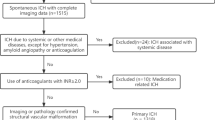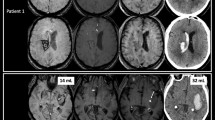Abstract
Purpose
Follow-up MRI/MRA is historically obtained as outpatient when patients with a spontaneous intracerebral hemorrhage (ICH) have an initial MRI/MRA that is negative for an underlying structural lesion. However, the utility of repeating MR imaging in a delayed fashion remains uncertain.
Methods
We retrospectively reviewed 396 patients with spontaneous ICH admitted at our institution between 2015 and 2017 and selected those whose initial MRI/MRA was negative for an underlying structural lesion and those who underwent follow-up MR imaging in a delayed fashion.
Results
A total of 113 patients met the study criteria. The average age of those with negative follow-up MRI/MRA was 65.0 ± 12.6 (IQR: 55.0–74.0) years old. None of the 113 patients with a negative inpatient MRI/MRA had an underlying structural lesion on follow-up MRI/MRA (0%, 95% CI 0.0–0.032, p < 0.001). The mean time of the follow-up imaging from the initial study was 105.7 days (median: 62 days; IQR: 42.5–100.5). Of the 113, 83 (73.5%) underwent follow-up MRI with and without gadolinium, while 30 (26.5%) patients did not receive gadolinium.
Conclusion
Delayed follow-up MRI in patients with a negative initial MRI/MRA for workup of spontaneous ICH was not diagnostic in any of the patients included in the study. Our study suggests that a routine follow-up MRI for this patient population is not necessary.
Similar content being viewed by others
References
Hemphill JC, Greenberg SM, Anderson CS, Becker K, Bendok BR, Cushman M et al (2015) Guidelines for the management of spontaneous intracerebral hemorrhage. Stroke 46(7):2032–2060. https://doi.org/10.1161/STR.0000000000000069
Morgenstern LB, Hemphill JC, Anderson C, Becker K, Broderick JP, Connolly ES, Greenberg SM, Huang JN, MacDonald RL, Messe SR, Mitchell PH, Selim M, Tamargo RJ, American Heart Association Stroke Council and Council on Cardiovascular Nursing (2010) Guidelines for the management of spontaneous intracerebral hemorrhage: a guideline for healthcare professionals from the American Heart Association/American Stroke Association. Stroke. https://doi.org/10.1161/STR.0b013e3181ec611b
Macellari F, Paciaroni M, Agnelli G, Caso V (2014) Neuroimaging in intracerebral hemorrhage. Stroke 45(3):903–908. https://doi.org/10.1161/STROKEAHA.113.003701
McDowell MM, Kellner CP, Barton SM, Mikell CB, Sussman ES, Heuts SG, Connolly ES (2013). The role of advanced neuroimaging in intracerebral hemorrhage. 34(4), E2. https://doi.org/10.3171/2013.1.Focus12409
Broderick J, Connolly S, Feldmann E et al (2007) Reprint. Circulation 116(16):e391–e413
Charidimou A, Shoamanesh A, Al-Shahi Salman R, Cordonnier C, Perry LA, Sheth KN, Biffi A, Rosand J, Viswanathan A (2018) Cerebral amyloid angiopathy, cerebral microbleeds and implications for anticoagulation decisions: the need for a balanced approach. Int J Stroke. https://doi.org/10.1177/1747493017741384
Cordonnier C, Klijn CJ, van Beijnum J, Al-Shahi Salman R (2010) Radiological investigation of spontaneous intracerebral hemorrhage: systematic review and trinational survey. Stroke. https://doi.org/10.1161/STROKEAHA.109.572495
Dylewski DA, Demchuk AM, Morgenstern LB (2000) Utility of magnetic resonance imaging in acute intracerebral hemorrhage. J Neuroimaging. https://doi.org/10.1111/jon200010278
Chalouhi N, Mouchtouris N, Al Saiegh F, Das S, Sweid A, Flanders AE, Starke RM, Baldassari MP, Tjoumakaris S, Gooch MR, Shah SO, Hasan D, Herial N, D'Ambrosio R, Rosenwasser R, Jabbour P (2019) Analysis of the utility of early MRI/MRA in 400 patients with spontaneous intracerebral hemorrhage. J Neurosurg. https://doi.org/10.3171/2019.2.JNS183425
Funding
No funding was received for this study.
Author information
Authors and Affiliations
Corresponding author
Ethics declarations
Conflict of interest
The authors declare that they have no conflict of interest.
Ethical approval
No procedures were performed in this study. This study was conducted in accordance with the ethical standards of the institutional and national research committee and with the 1964 Helsinki Declaration and its later amendments or comparable ethical standards.
Informed consent
Informed consent was not required as per the study protocol that was reviewed and approved by the Thomas Jefferson University Institutional Review Board.
Additional information
Publisher’s note
Springer Nature remains neutral with regard to jurisdictional claims in published maps and institutional affiliations.
Rights and permissions
About this article
Cite this article
Mouchtouris, N., Saiegh, F.A., Chalouhi, N. et al. Low diagnostic yield in follow-up MR imaging in patients with spontaneous intracerebral hemorrhage with a negative initial MRI. Neuroradiology 63, 1009–1012 (2021). https://doi.org/10.1007/s00234-020-02570-1
Received:
Accepted:
Published:
Issue Date:
DOI: https://doi.org/10.1007/s00234-020-02570-1




